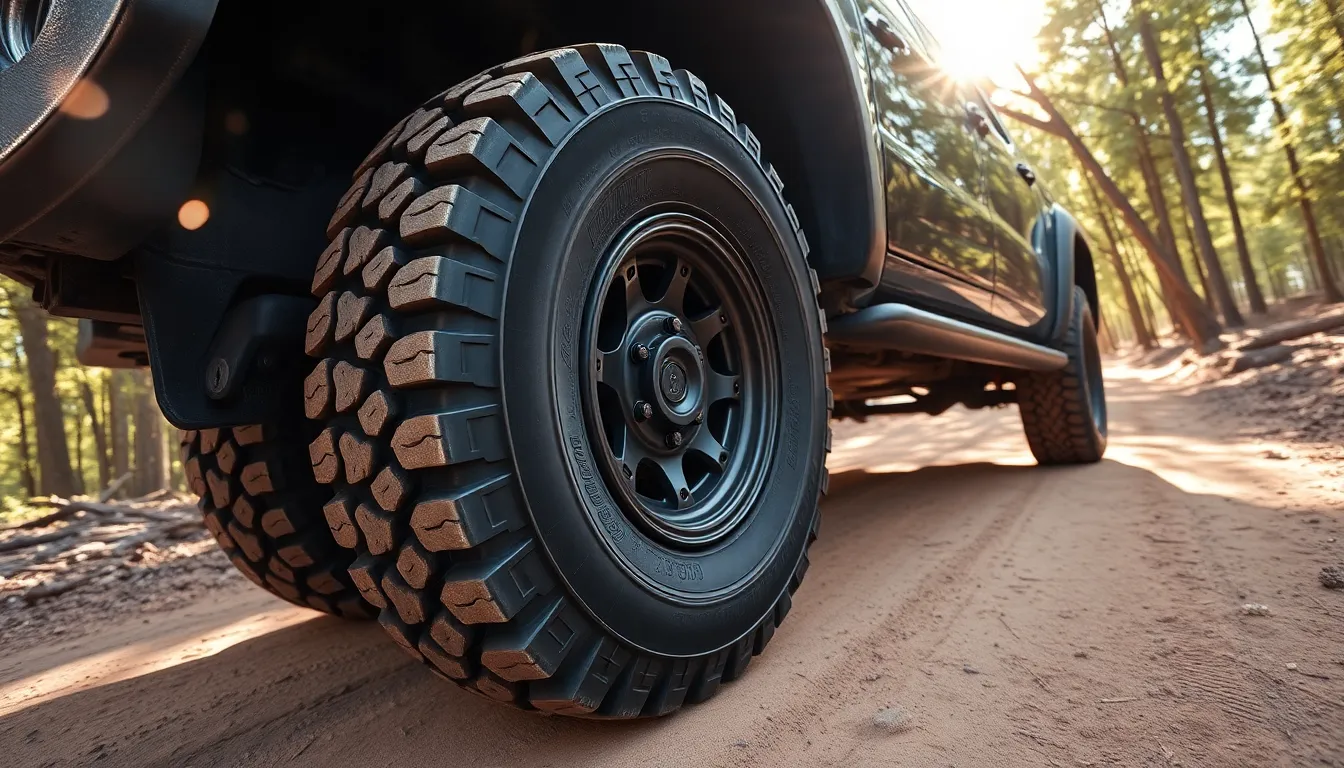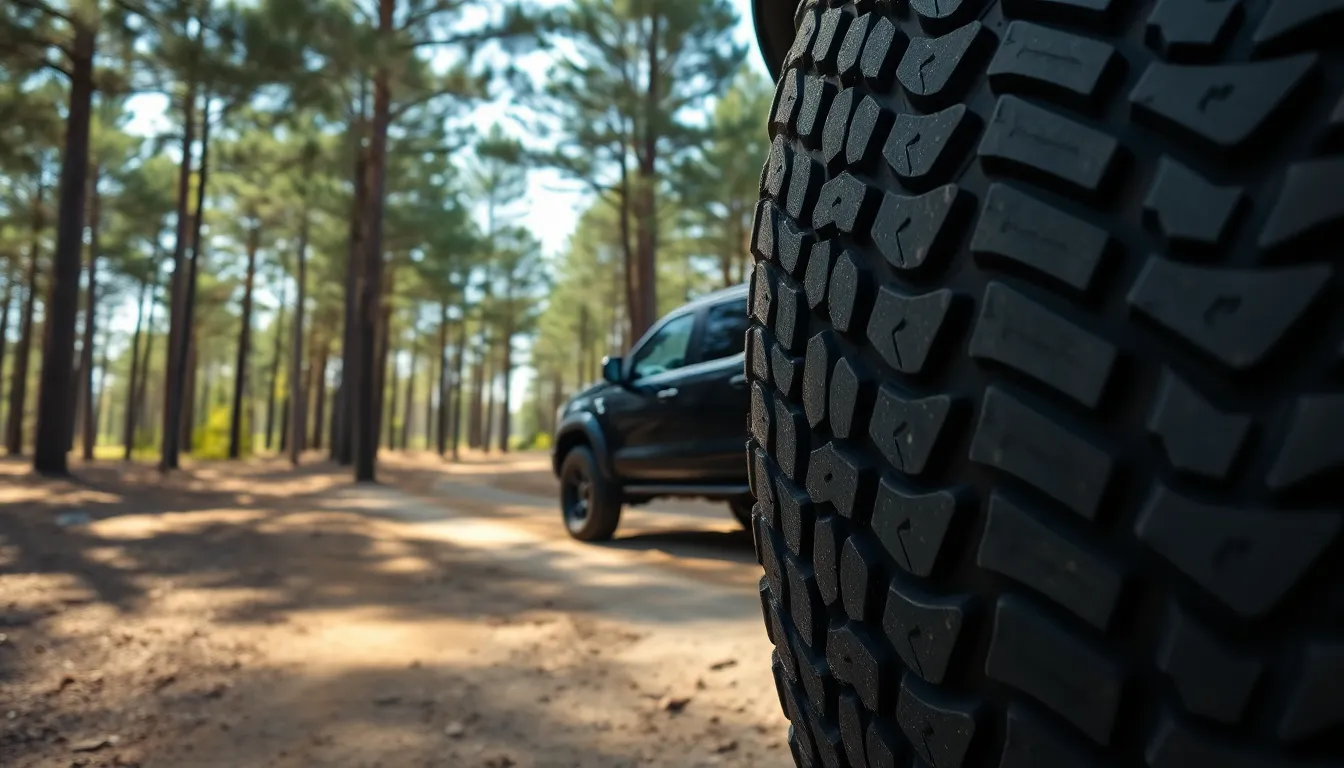When we’re shopping for new tires or comparing specifications, understanding tire size measurements becomes crucial for making informed decisions. The designation 275/65 R20 might look like a complex code, but it’s actually a straightforward system that tells us everything we need to know about our tire’s dimensions.
Converting 275/65 R20 to inches helps us visualize the actual size and determine if these tires will fit our vehicle properly. This popular tire size is commonly found on trucks, SUVs, and larger vehicles, making it essential knowledge for many drivers.
We’ll break down each number in this tire code and show you exactly how to calculate the dimensions in inches. By the end of this guide, you’ll confidently understand not only what 275/65 R20 measures in inches but also how to apply this knowledge when selecting the perfect tires for your ride.
Understanding Tire Size 275/65R20
We encounter tire size codes daily but often overlook their precise meaning. Understanding the 275/65R20 designation helps us make informed tire purchasing decisions and ensures proper vehicle fitment.
Breaking Down the Tire Size Code
Tire size codes follow a standardized format established by the Tire and Rim Association. Each segment of the 275/65R20 code represents exact tire dimensions and construction details that determine compatibility with our vehicles.
The forward slash separates the tire width from the aspect ratio. Letter designations indicate construction type and speed ratings. Numbers following the construction letter specify wheel diameter measurements.
Modern tire sizing systems use metric measurements for width and millimeter specifications for most dimensions. Converting these measurements to inches provides clearer visualization for many vehicle owners in the United States.
What Each Number Represents
| Code Segment | Measurement | Description |
|---|---|---|
| 275 | Width in millimeters | Tire width from sidewall to sidewall |
| 65 | Aspect ratio percentage | Sidewall height as percentage of width |
| R | Radial construction | Internal tire structure type |
| 20 | Rim diameter in inches | Wheel size the tire fits |
The first number 275 indicates tire width measured in millimeters across the tread surface. This measurement represents the distance between the outer edges of the tire sidewalls when mounted on the specified rim width.
Aspect ratio 65 expresses sidewall height as a percentage of tire width. Calculating sidewall height requires multiplying the tire width by the aspect ratio percentage then dividing by 100.
Construction designation R specifies radial tire construction where internal cords run perpendicular to the direction of travel. Radial construction provides better fuel economy and longer tread life compared to bias ply alternatives.
Final number 20 represents rim diameter measured in inches from bead seat to bead seat. This measurement determines which wheel sizes accommodate the tire and affects overall tire diameter calculations.
Converting 275/65R20 to Inches

Converting 275/65R20 tire dimensions from metric to imperial measurements requires systematic calculations for each component. We’ll break down each measurement to provide precise inch equivalents for this popular truck and SUV tire size.
Width Measurement in Inches
The 275 millimeter tire width converts to 10.83 inches when divided by 25.4 (the conversion factor from millimeters to inches). This measurement represents the tire’s tread width from sidewall to sidewall when properly mounted and inflated. Most truck owners find this width specification easier to visualize in inches rather than millimeters.
| Measurement | Millimeters | Inches |
|---|---|---|
| Tire Width | 275 mm | 10.83 in |
Sidewall Height Calculation
The sidewall height equals 65% of the 275mm width, calculating to 178.75 millimeters or 7.04 inches. This aspect ratio of 65 creates a balanced profile between ride comfort and handling performance. We determine this measurement by multiplying the tire width (275mm) by the aspect ratio percentage (0.65).
| Component | Calculation | Result |
|---|---|---|
| Sidewall Height (mm) | 275 × 0.65 | 178.75 mm |
| Sidewall Height (in) | 178.75 ÷ 25.4 | 7.04 in |
Overall Diameter in Inches
The complete tire diameter measures 35.08 inches when combining the 20-inch rim diameter with both sidewall heights. We calculate this by adding the rim diameter (20 inches) to twice the sidewall height (7.04 × 2 = 14.08 inches). This overall diameter affects vehicle ground clearance, speedometer accuracy, and gear ratios in trucks and SUVs.
| Measurement | Calculation | Result |
|---|---|---|
| Overall Diameter | 20 + (7.04 × 2) | 35.08 in |
| Circumference | 35.08 × π | 110.17 in |
Real-World Dimensions of 275/65R20 Tires

Understanding the physical dimensions of 275/65R20 tires helps us visualize how these tires perform on trucks and SUVs. These measurements provide crucial information for determining vehicle clearance and fitment compatibility.
Total Tire Height and Width
The 275/65R20 tire measures 35.08 inches in total diameter from top to bottom. This height calculation combines the 20-inch rim diameter with two sidewall sections measuring 7.04 inches each. The tire’s width spans 10.83 inches across the tread surface.
| Dimension | Measurement |
|---|---|
| Total Diameter | 35.08 inches |
| Tire Width | 10.83 inches |
| Sidewall Height | 7.04 inches |
| Rim Diameter | 20 inches |
These dimensions create a substantial tire footprint that provides excellent stability for larger vehicles. The 35-inch overall diameter positions the vehicle approximately 17.54 inches above ground level at the tire’s center point.
Comparison to Standard Measurements
The 275/65R20 tire sits between common truck tire sizes in terms of overall dimensions. Compared to a 265/70R17 tire measuring 31.6 inches in diameter, our 275/65R20 adds 3.48 inches of additional height. The width difference between these sizes spans 0.43 inches, with the 275 section being wider.
Standard pickup truck tires like 245/75R16 measure 30.5 inches in diameter, making the 275/65R20 significantly taller by 4.58 inches. Popular SUV sizes such as 255/70R18 reach 32.1 inches in diameter, creating a 2.98-inch height difference compared to our 275/65R20 specification.
The 275/65R20 tire closely matches 33-inch aftermarket tires in overall diameter while maintaining street-friendly characteristics. Off-road enthusiasts often compare this size to 285/65R20 tires, which measure 35.6 inches in diameter and provide 0.52 inches of additional height.
Popular Vehicles That Use 275/65R20 Tires

Many truck and SUV manufacturers equip their vehicles with 275/65R20 tires from the factory. These tires provide an optimal balance between performance and comfort for larger vehicles.
Trucks and SUVs
Ford F-150 models from 2015 onwards commonly feature 275/65R20 tires as standard equipment on higher trim levels. Chevrolet Silverado 1500 trucks also use this tire size across multiple trim packages, particularly on LTZ and High Country variants.
Ram 1500 pickups incorporate 275/65R20 tires on their Laramie and Limited editions to enhance ride quality. Toyota Tundra trucks employ this tire size on SR5 and Limited trims, providing excellent load-carrying capacity.
Large SUVs frequently use 275/65R20 tires for their versatility. Chevrolet Tahoe and Suburban models feature these tires on LT and Premier trims. Ford Expedition SUVs come equipped with 275/65R20 tires on XLT and Limited versions.
Nissan Armada full-size SUVs use this tire size across their lineup for optimal ground clearance. Toyota Sequoia models incorporate 275/65R20 tires on SR5 and Limited trims to handle family hauling duties.
Performance Considerations
275/65R20 tires deliver superior traction on various road surfaces compared to smaller tire sizes. The 10.83-inch width provides increased contact patch area, improving grip during acceleration and braking scenarios.
Fuel economy experiences a slight decrease with 275/65R20 tires due to increased rolling resistance and weight. Vehicles typically see a 1-2 MPG reduction compared to smaller tire alternatives.
Load capacity increases significantly with this tire size, accommodating heavier payloads and towing requirements. Most 275/65R20 tires support load indexes between 113-116, translating to 2,535-2,756 pounds per tire.
Ride comfort improves with the 7.04-inch sidewall height, which absorbs road imperfections more effectively than lower-profile tires. Off-road capability enhances due to the larger overall diameter and increased ground clearance.
Speedometer accuracy requires attention when switching to 275/65R20 tires from different sizes. The 35.08-inch overall diameter affects gear ratios and may necessitate recalibration for precise readings.
Benefits and Drawbacks of 275/65R20 Size

The 275/65R20 tire size offers distinct advantages and disadvantages that truck and SUV owners must evaluate before making a purchase decision. Understanding these trade-offs helps us make informed choices for our exact driving needs and vehicle requirements.
Ride Comfort and Handling
275/65R20 tires deliver enhanced ride comfort through their larger sidewall height of 7.04 inches, which provides better shock absorption over rough terrain and potholes. The increased sidewall flex reduces road vibration transmission to the cabin, creating a smoother driving experience on both highways and city streets. Off-road performance improves significantly with these tires, as the larger contact patch and sidewall flexibility offer superior traction on gravel, dirt, and uneven surfaces.
Cornering stability benefits from the wider 10.83-inch tread width, which distributes vehicle weight more evenly across the road surface. The 20-inch rim diameter maintains responsive steering feel while the taller overall height of 35.08 inches increases ground clearance by approximately 1-2 inches compared to standard truck tire sizes. Braking performance sees marginal improvements due to the larger contact area, though the increased rotational mass slightly extends stopping distances.
Load carrying capacity increases with 275/65R20 tires, as most models in this size support higher weight ratings than smaller alternatives. Towing applications particularly benefit from the enhanced stability and heat dissipation characteristics of these larger tires.
Fuel Economy Impact
Fuel economy typically decreases by 3-5% when switching to 275/65R20 tires from smaller factory sizes due to increased rolling resistance and rotational weight. The larger 35.08-inch diameter creates higher aerodynamic drag, requiring more engine power to maintain highway speeds. Rolling resistance increases proportionally with the wider 10.83-inch contact patch, as more tire surface contacts the road during each revolution.
Weight penalties contribute to reduced efficiency, as 275/65R20 tires often weigh 5-10 pounds more per tire than smaller alternatives. The additional unsprung weight affects acceleration performance and requires more energy for both speeding up and slowing down. Highway driving shows the most pronounced fuel economy impact, while city driving efficiency remains relatively stable.
Speedometer recalibration becomes necessary with 275/65R20 tires, as the larger diameter causes actual speeds to exceed displayed speeds by approximately 6-8%. Gear ratio changes effectively make each gear “taller,” which can reduce engine RPM at cruising speeds but may require more frequent downshifting during acceleration or hill climbing.
Alternative Tire Sizes to Consider

Several tire sizes provide comparable dimensions to the 275/65R20 while offering different performance characteristics. We’ve identified multiple options that maintain similar overall diameter measurements for proper fitment.
Similar Dimensions in Different Formats
The 285/60R20 delivers nearly identical overall diameter at 35.0 inches while providing increased width at 11.22 inches. This size offers enhanced traction and stability for heavy-duty applications. The 295/55R20 produces a 35.0-inch diameter with maximum width at 11.61 inches, creating superior grip for performance driving.
| Tire Size | Width (inches) | Sidewall Height (inches) | Overall Diameter (inches) |
|---|---|---|---|
| 275/65R20 | 10.83 | 7.04 | 35.08 |
| 285/60R20 | 11.22 | 6.73 | 35.00 |
| 295/55R20 | 11.61 | 6.38 | 35.00 |
| 265/70R18 | 10.43 | 7.30 | 34.58 |
| 255/75R18 | 10.04 | 7.53 | 34.10 |
Different rim sizes accommodate varying vehicle configurations while maintaining functional diameter ranges. The 265/70R18 measures 34.58 inches in diameter with slightly taller sidewalls at 7.30 inches. Budget-conscious options include the 255/75R18 at 34.10 inches diameter for older truck models requiring cost-effective replacements.
Plus Sizing Options
Plus one configurations use 21-inch rims with lower profile tires for enhanced handling characteristics. The 275/55R21 maintains 35.0-inch diameter while reducing sidewall flex through decreased height at 5.95 inches. Performance gains include improved cornering response and reduced tire squirm during aggressive driving.
Plus two setups employ 22-inch wheels with ultra-low profile rubber for maximum visual impact. The 275/45R22 produces 34.7-inch diameter with minimal sidewall at 4.87 inches height. These configurations suit custom applications prioritizing appearance over ride comfort.
Downsizing presents practical advantages for winter driving and cost savings. The 245/75R17 delivers 33.5-inch diameter at reduced purchase prices and improved snow traction. Alternative 17-inch options include the 265/70R17 at 33.6 inches for maintaining ground clearance while accessing budget tire selections.
Conclusion
Understanding tire specifications like 275/65R20 empowers us to make informed decisions about our vehicles. When we know that these tires measure 35.08 inches in diameter and 10.83 inches in width we can better evaluate whether they’ll meet our driving needs.
These measurements directly impact everything from fuel economy to speedometer accuracy. Whether we’re upgrading for improved traction or considering alternatives for exact driving conditions having this dimensional knowledge helps us choose the right tire size.
The 275/65R20 remains a versatile choice for truck and SUV owners who want balanced performance. With proper understanding of these measurements we can confidently select tires that enhance our vehicle’s capabilities while meeting our budget and performance expectations.
Frequently Asked Questions
What does the tire size 275/65R20 mean?
The 275/65R20 tire size indicates specific measurements: 275 represents the tire width in millimeters (10.83 inches), 65 is the aspect ratio showing sidewall height as a percentage of width, R indicates radial construction, and 20 specifies the rim diameter in inches. This combination creates a tire with a 35.08-inch overall diameter.
What vehicles commonly use 275/65R20 tires?
Popular vehicles equipped with 275/65R20 tires include the Ford F-150, Chevrolet Silverado 1500, Ram 1500, Toyota Tundra, Chevrolet Tahoe, and Nissan Armada. These tires are commonly found on full-size trucks and SUVs where manufacturers seek an optimal balance between performance, comfort, and capability.
How do 275/65R20 tires affect fuel economy?
Switching to 275/65R20 tires typically decreases fuel economy by 3-5% compared to smaller tire sizes. This reduction occurs due to increased rolling resistance and weight from the larger tire dimensions. The wider tread and taller sidewall create more contact with the road surface, requiring additional energy to maintain speed.
Do I need to recalibrate my speedometer with 275/65R20 tires?
Yes, speedometer recalibration may be necessary when switching to 275/65R20 tires if they’re significantly larger than your original tires. The increased overall diameter can cause your actual speed to exceed the displayed speed, affecting gear ratios and potentially impacting driving performance and accuracy.
What are the main benefits of 275/65R20 tires?
The 275/65R20 tire size offers enhanced ride comfort through improved shock absorption, better traction on rough terrain due to the taller sidewall, increased load capacity for towing applications, and superior cornering stability from the wider tread width. These features make them ideal for truck and SUV applications.
What are alternatives to 275/65R20 tires?
Popular alternatives include 285/60R20 and 295/55R20 for wider tread with similar diameter, plus-sizing options like 21-inch or 22-inch rim configurations for enhanced handling, or downsizing to 245/75R17 and 265/70R17 for winter driving and cost savings while maintaining ground clearance.








